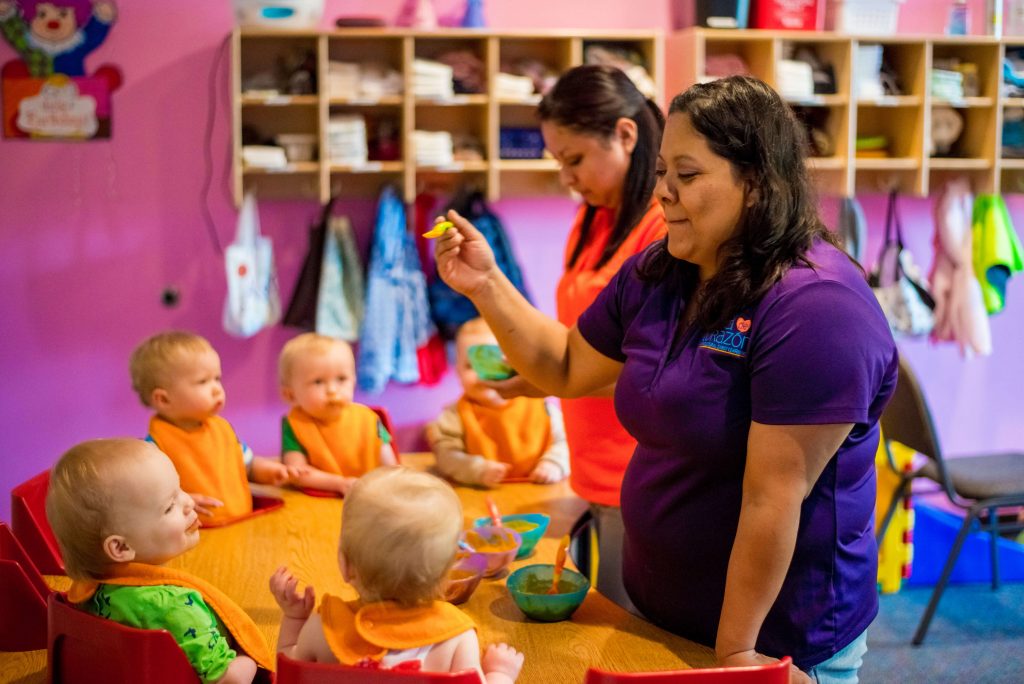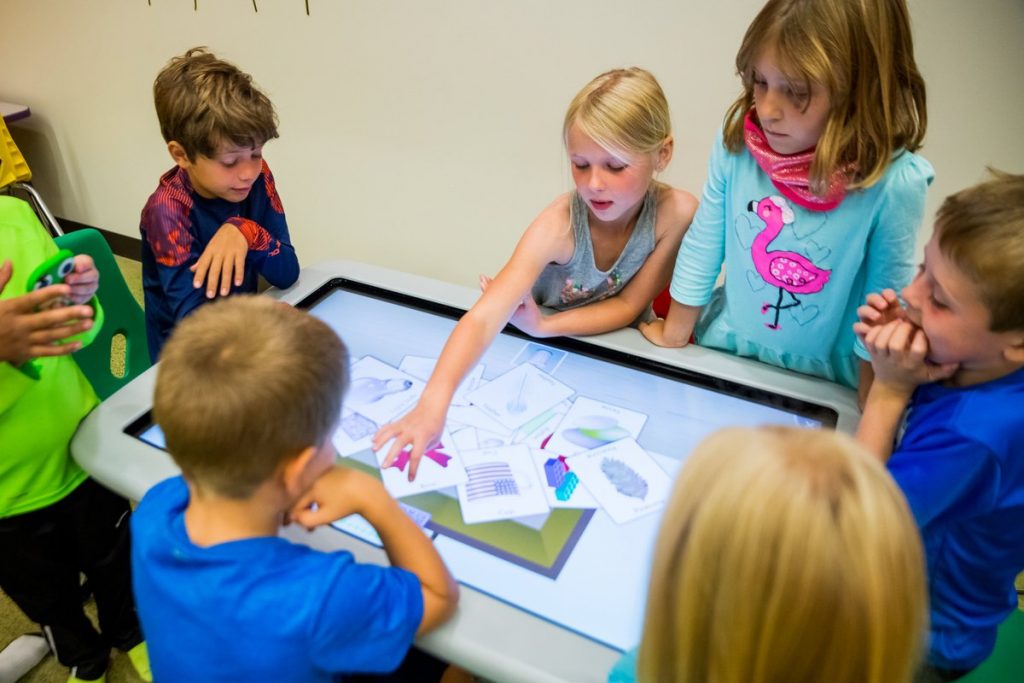Daycare vs. Preschool: What’s the Difference?

Choosing care for your child is one of the first big parenting decisions and it’s not always easy. While ‘daycare’ and ‘preschool’ are sometimes used interchangeably, they serve different purposes.
Daycare centers (also known as childcare centers) typically serve a broad age range from infants as young as 6 weeks old up to age 5 or beyond. These programs are designed to provide full-day supervision, often year-round, and are especially helpful for families needing consistent care during working hours. Preschools, by contrast, generally serve children aged 3 to 5 years and place greater emphasis on learning and school readiness.
We’ll break down the specific differences between daycare and preschool, including age groups served, educational focus, caregiver qualifications, scheduling and costs so you can make an informed, confident choice for your child and family.
What is Daycare?
Daycare provides supervised care for children while parents are at work or school. These programs support both basic needs and early development through play and routine.
Daycare can be center-based or home-based (family daycare), and tends to serve a wider age range than preschools, including:
- Infants (6 weeks–12 months)
- Toddlers (1–3 years)
- Preschoolers (3–5 years)
- Some even care for school-age children in afterschool settings
Classrooms may be grouped by age or mixed-age, especially in smaller home-based programs.

What is Preschool?
Preschool is an early childhood education program focused on preparing children for kindergarten. Typically serving children ages 2.5 or 3 to 5, preschool emphasizes structured learning, social-emotional development and cognitive growth through a play-based, academic or blended curriculum.
These programs support children as they develop language skills, problem-solving abilities and independence within a nurturing, group learning environment.
Preschools may operate as private, public, or part of a broader childcare center. Depending on the program, daily schedules can be part-time (a few hours per day) or full-time, and many follow a traditional school-year calendar.
Key Differences between Daycare and Preschool
While daycare and preschool both provide care for young children, they serve different core purposes. Choosing between the two often depends on factors like a child’s age, a family’s schedule and budget and their goals for the child’s early development. Here are some of the key differences you’ll find between daycare and preschool:
Age Group Requirements
Daycares typically serve a wider age range, from 6 weeks to 5 or 6 years, and sometimes older in afterschool care. They often have separate classrooms for infants, toddlers and preschoolers, and don’t require toilet training. Staff are trained to support children at various stages, including diapering, feeding and naps.
Preschools generally serve children ages 2.5 to 5, focusing on school readiness through structured learning and socialization. Many require potty training, and some have age cutoffs, developmental milestones, or formal enrollment periods.
For infants and toddlers, daycare is usually the better option due to flexibility and broader age acceptance. Preschool suits older children who are toilet trained and ready for a structured group environment.
Educational Focus and Curriculum
Daycare programs primarily focus on providing a safe, nurturing environment where children’s basic needs—like meals, naps, hygiene and supervised play—are met. Some daycares include developmental activities, but they may not follow a formal curriculum, especially for infants and toddlers. The emphasis is more on care and comfort than structured academics.
Preschools are intentionally designed to prepare children for kindergarten. They follow a structured curriculum focused on early literacy, math, problem-solving and social-emotional growth. Most are led by educators trained in early childhood education and incorporate guided learning, creative play and routine-based instruction. Many preschools use a play-based approach to help children build key skills in a fun, engaging way.
These differences make preschool a strong choice for families seeking a learning-rich environment, and daycare ideal for families who prioritize flexibility, multi-age care and nurturing support.

Hours and Calendar Schedules
Daycare centers are typically designed to support working families, offering longer hours, often from 7 a.m. to 6 p.m., Monday through Friday, and remaining open year-round, including during summer and school breaks. Some may even offer care on weekends or holidays.
Preschools, in contrast, usually operate on a school-year schedule with shorter daily hours, often part-time. While some programs provide extended care or summer camps, these services often come with additional fees.
For families needing full-day, year-round care, daycare tends to offer more flexibility and convenience. Preschool may be better suited for families with more flexible routines or those focused on early learning and kindergarten readiness, but extra planning may be required for out-of-school time.
Caregivers and Teachers
Preschool teachers are often required to have formal education in early childhood development or education, such as an associate or bachelor’s degree, and may hold certifications like a CDA (Child Development Associate) or a state teaching credential.
Daycare staff qualifications can vary depending on the type of program and state requirements. Caregivers often need basic safety and care certifications such as CPR, First Aid and state childcare licensing, but formal degrees are not always mandatory—especially in home-based programs. While directors or lead caregivers may have training in child development, emphasis in daycare (particularly for infants and toddlers) is typically on nurturing and attentive care over structured instruction.
Despite these differences, both daycare and preschool staff share a common goal: creating a space where children are safe, supported and encouraged to grow. In both settings, caregivers are trained to foster social-emotional development, promote communication and respond to each child’s unique needs with compassion and patience.

Costs and Funding
Daycare is typically privately funded and paid out-of-pocket. The cost of daycare depend on a child’s age (with infant care being the most expensive), hours of care and any extra services offered. While publicly funded or subsidized daycare is less common, some support is available for low-income families through programs such as:
- Temporary Assistance for Needy Families (TANF)
- State childcare assistance programs
Preschools may be private or publicly funded.
- Private preschools charge tuition, which can be comparable to or slightly less than daycare depending on the program.
- Public preschools (like Head Start or state-funded Pre-K) are often free or low-cost and may be offered through local school districts or federally funded initiatives.
Several factors influence cost, whether for daycare or preschool:
- Location: Urban areas like New York City or San Francisco typically have higher tuition.
- Program Quality: Centers with trained teachers, specialized curricula, or offerings like bilingual immersion often charge more.
- Schedule: Full-day and extended hours generally cost more than part-time care.
Many states and cities offer free or low-cost public preschool for qualifying families—especially for 4-year-olds—through programs like Head Start or state Pre-K initiatives. These options are expanding but vary by location. In contrast, free daycare for infants and toddlers is far less common, though financial assistance can be available for eligible families.
Benefits of Choosing Daycare
Daycare offers a wide range of advantages for both children and families—especially those needing reliable, full-day care. Some of these benefits include:
- Flexible Hours for Working Parents
Most daycare centers offer extended hours, typically from 7 a.m. to 6 p.m., making them ideal for parents who work full-time or have less predictable schedules.
- Year-Round Care
Daycares usually remain open during school breaks, holidays and teacher workdays, providing consistent care throughout the year.
- Supports a Wide Age Range
Accepting children from 6 weeks to 5+ years, daycare can serve families with children at different developmental stages—even siblings in the same center.
- Socialization Opportunities
Frequent interaction with peers helps children develop key social skills like sharing, cooperation, communication and conflict resolution starting at an early age.
- Safe and Supervised Environment
Licensed daycares follow strict guidelines for staff training, safety protocols and child-to-caregiver ratios, ensuring a secure environment every day.
- Developmentally Appropriate Activities
Many daycares include play-based learning, sensory exploration and motor-skill activities tailored to each age group, even without a formal academic curriculum.
- Supports Early Emotional Development
Trusted, consistent caregivers help young children form secure attachments and build confidence, emotional expression and resilience.
- Helps Develop Routines and Structure
Daily schedules that include meals, naps and playtime support children’s sense of stability, improve behavior and make transitions easier.
- Foundation for Preschool
Daycare gives toddlers and preschoolers early exposure to group learning settings, helping them build skills that prepare them for preschool and beyond.
- Care Is Available Even if a Child Isn’t Potty-Trained
Unlike many preschools, daycares welcome children who are not yet toilet-trained and often assist with potty training as part of daily care.
Benefits of Choosing a Preschool
Preschools are thoughtfully designed to help children build the skills and confidence they need for a successful transition to kindergarten. Some benefits of choosing a preschool include:
- Kindergarten Readiness
Preschools help children build fundamental academic skills—like early literacy, math and problem-solving—while also strengthening classroom behaviors such as following instructions and participating in group activities.
- Structured Learning in a Play-Based Format
Children learn through hands-on play, guided by trained educators who plan activities with developmentally appropriate goals, balancing academic themes with creative exploration.
- Enhanced Communication and Language Skills
In preschool, children are immersed in rich language experiences—storytelling, songs, discussions—that help them learn to express themselves, ask questions and grow their vocabulary.
- Supports Bilingual or Second Language Learning
Many preschools, including Casa de Corazón, offer Spanish immersion or bilingual programs that introduce children to a second language during the optimal window for language acquisition.
- Improved Social and Emotional Development
Group activities and peer interactions help children build empathy, learn to manage emotions and gain confidence in navigating friendships and group dynamics.
- Routine and Predictability
A consistent daily schedule helps children understand structure, build time awareness and feel more secure in transitioning between tasks and activities.
- Qualified Early Education Staff
Preschool teachers often have specialized training in early childhood education, allowing them to tailor learning experiences to each child’s growth and needs.
- Nurtures Independence and Responsibility
Teachers encourage children to take ownership of small tasks—like cleaning up or managing emotions—helping them build confidence and autonomy.
- Supports Cognitive and Motor Development
Creative activities like drawing, building, pretend play and puzzles develop both fine and gross motor skills, along with early critical thinking and problem-solving abilities.
- Encourages Parental Involvement and Community Connection
Preschools often foster strong home-school connections through parent updates, events and communication, creating a sense of community around each child’s development.
Preschool or Daycare — How Do I Choose?
Choosing between daycare and preschool depends on your child’s needs and your family’s schedule, budget, and priorities. Here’s what to consider:
- Visit programs, observe classrooms and ask about curriculum, routines
,and safety.
- Check licensing and teacher credentials.
- Look for flexibility that fits your schedule.
- Trust your instincts—choose the setting where your child feels comfortable and supported.
Discover a Preschool Program that Celebrates Cultural Diversity
Preschool is a meaningful step in a child’s early education—providing foundational skills, social development and exposure to structured learning in a supportive environment. For families seeking more than just academics, finding a preschool that also promotes cultural awareness and global citizenship can be especially impactful.
Casa de Corazón is a leading full-day bilingual preschool that nurtures children’s development through Spanish immersion, play-based learning and a strong emphasis on social responsibility. Casa classrooms are vibrant, inclusive spaces where children build language skills, explore other cultures and develop empathy—while preparing for kindergarten and beyond.
If you’re located in Minnesota or Wisconsin and looking for a preschool that celebrates diversity and values early learning, Casa de Corazón invites you to learn more.

